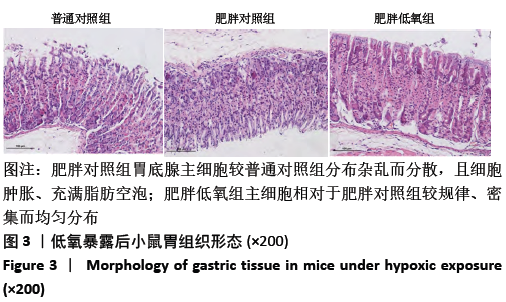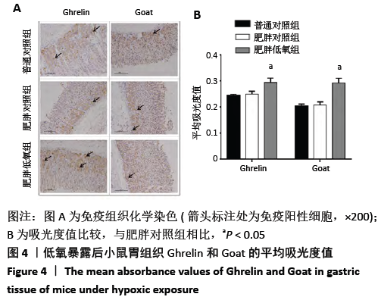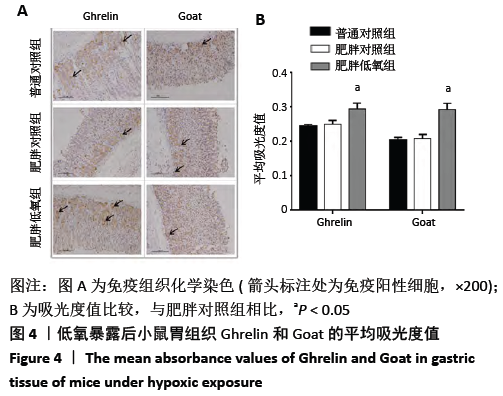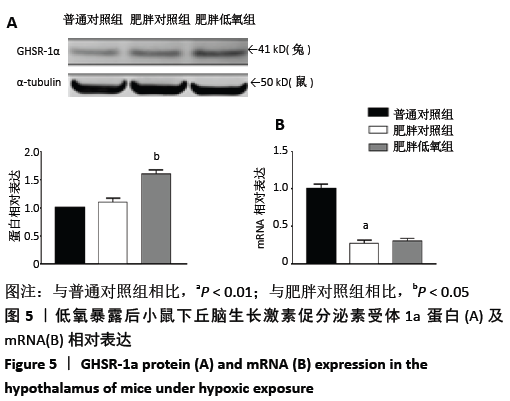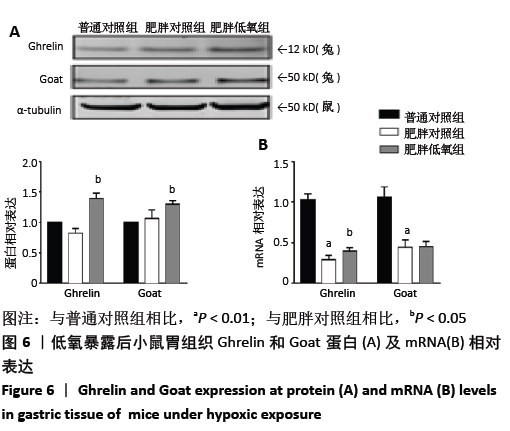Chinese Journal of Tissue Engineering Research ›› 2021, Vol. 25 ›› Issue (11): 1733-1739.doi: 10.3969/j.issn.2095-4344.3098
Previous Articles Next Articles
Change of Ghrelin-GHSR pathway in 4-week intermittent hypoxic exposure improving obesity in mice
Yang Luyao1, 2, Fu Pengyu2, Tang Shuning2, Zhu Rongxin3, Gong Lijing1
- 1China Institute of Sport and Health, 2School of Sports and Human Sciences, Beijing Sport University, Beijing 100084, China; 3Shanghai Research Institute of Sports Science, Shanghai 200030, China
-
Received:2020-03-23Revised:2020-03-28Accepted:2020-05-09Online:2021-04-18Published:2020-12-21 -
Contact:Gong Lijing, PhD, Assistant researcher, China Institute of Sport and Health, Beijing Sport University, Beijing 100084, China -
About author:Yang Luyao, 1China Institute of Sport and Health, 2School of Sports and Human Sciences, Beijing Sport University, Beijing 100084, China -
Supported by:Beijing Training Problem of Innovation and Entrepreneurship for Undergraduates, No. 201910043040 (to YLY)
CLC Number:
Cite this article
Yang Luyao, Fu Pengyu, Tang Shuning, Zhu Rongxin, Gong Lijing . Change of Ghrelin-GHSR pathway in 4-week intermittent hypoxic exposure improving obesity in mice[J]. Chinese Journal of Tissue Engineering Research, 2021, 25(11): 1733-1739.
share this article

2.1 实验动物数量分析 排除肥胖建模失败的6只小鼠,干预结束时小鼠数量为24只,后续各组均无小鼠流失,全部进入结果分析。 2.2 小鼠体质量、摄食量 小鼠初始体质量为(8.81±0.40) g。8周高脂饲料饲养后,高脂膳食组(肥胖对照组和肥胖低氧组)体质量分别为(24.83±1.44) ,(24.72±1.31) g,超过普通对照组(21.32±0.31) g体质量的20%,说明成功建立肥胖模型。低氧暴露2周时,肥胖对照组(26.32±1.14) g的体质量显著高于普通对照组(21.61±0.93) g(P < 0.01),见图1。干预4周后,肥胖对照组(27.92±1.44) g体质量显著高于普通对照组(26.33±1.61) g和肥胖低氧组(26.67±1.87) g(P < 0.05)。 "
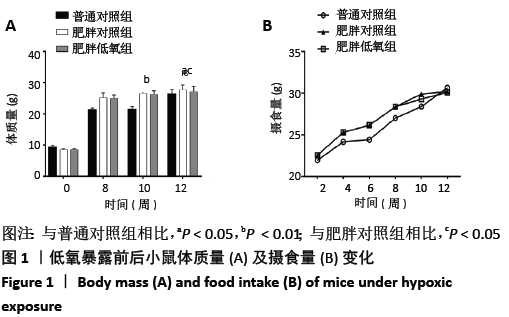
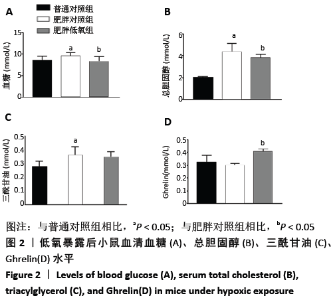
普通对照组饲喂普通维持饲料,高脂膳食组饲喂高脂饲料,前8周,普通对照组每周摄食量(该组所有小鼠的单周摄食总量)稍低于高脂膳食组,但无显著差异。低氧暴露2周(第10周),肥胖低氧组高脂饲料摄食量较肥胖对照组下降;低氧暴露4周时(第12周),肥胖低氧组与肥胖对照组的摄食量逐渐接近。 2.3 小鼠血清生化指标和Ghrelin水平 肥胖对照组血糖(10.21±1.81) mmol/L、总胆固醇(0.12±0.01) mmol/L、三酰甘油(0.34±0.03) mmol/L水平显著高于普通对照组[血糖为(8.53±0.81) mmol/L、总胆固醇为(0.05±0.00) mmol/L、三酰甘油为(0.29±0.02) mmol/L(P < 0.05)],见图2。低氧暴露干预4周后,肥胖低氧组血糖(8.06±1.31) mmol/L、总胆固醇(0.10± 0.01) mmol/L水平显著低于肥胖对照组(P < 0.05);肥胖低氧组三酰甘油为(0.35±0.16) mmol/L,与肥胖对照组无显著性差异;肥胖低氧组血清Ghrelin水平(0.40±0.02) mmol/L显著高于肥胖对照组(0.30±0.01) mmol/L(P < 0.05),见图2D。 "
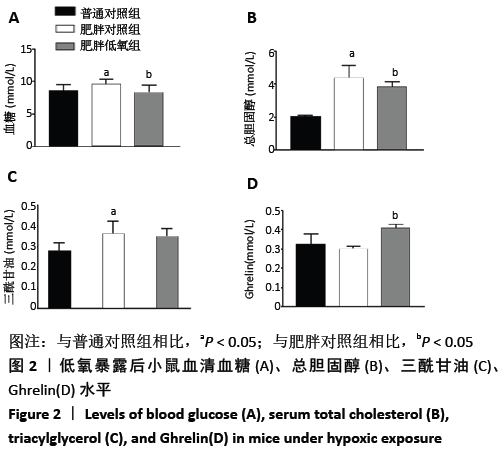
| [1] SHENG C, LI R, YANG P, et al. The correlation and relationship of obesity and cancer: a possible research perspective.Chin-Ger J Clin Oncol. 2013;12(8): 393-398. [2] SUI Y, ZHAO HL, WONG VCW, et al.A systematic review on use of Chinese medicine and acupuncture for treatment of obesity. Obes Rev. 2012;13(5):409-430. [3] Camilleri M. Peripheral mechanisms in appetite regulation.Gastroenterology. 2015;148(6):1219-1233. [4] MICHAEL C, HARMEET M, ANDRES A. Gastrointestinal Complications of Obesity. Gastroenterology. 2017;152(7):1656-1670. [5] 杨卫红,黄薇.胃肠功能与肥胖症[J].医学研究杂志,2015,44(1): 160-163+153. [6] 郭展宏,臧璞,邵加庆.胃饥饿素与糖脂代谢、能量平衡及肥胖的关系[J].中国糖尿病杂志,2019,27(4):316-320. [7] 郭展宏,臧璞,邵加庆.胃饥饿素对肥胖小鼠胰岛素抵抗的影响[J].医学研究生学报,2020,33(2):122-126. [8] 付鹏宇,龚丽景,朱镕鑫,等. Ghrelin-GHSR通路在急性低氧暴露大鼠胃炎症反应中的调节作用[J].中国生物化学与分子生物学报, 2018,34(10):1103-1110. [9] 尹悦,张炜真.胃X/A样细胞和肥胖[A]中国生理学会.中国生理学会第24届全国会员代表大会暨生理学学术大会论文汇编[C].中国生理学会,2014: 43. [10] KONOPKO-ZUBRZYCKA M, BANIUKIEWICZ A, WRÓBLEWSKI E, et al. The effect of intragastric balloon on plasma ghrelin, leptin, and adiponectin levels in patients with morbid obesity. J Clin Endocrinol Metab. 2009; 94(5):1644-1653. [11] 郭子君.运动对肥胖易感和抵抗大鼠内脏Ghrelin表达的影响[D].太原:山西大学, 2016. [12] ABIZAID A. Stress and obesity: The ghrelin connection. J Neuroendocrinol. 2019;31(7):12693. [13] BOYER SJ, BLUME FD. Weight loss and changes in body composition at high altitude.J Appl Physiol Respir Environ Exerc Physiol. 1984;57(5): 1580-1585. [14] KAYSER B, VERGES S. Hypoxia, energy balance and obesity: from pathophysiological mechanisms to new treatment strategies.Obes Rev. 2013;14(7):579-592. [15] WESTERTERP KR, KAYSER B. Body mass regulation at altitude.Eur J Gastroenterol Hepatol. 2006;18(1):1-3. [16] 李晓东.食源性肥胖大鼠模型的建立和电针治疗肥胖症作用机制的实验研究[D].天津医科大学,2003. [17] 付鹏宇,龚丽景,朱镕鑫,等.有氧运动对肥胖小鼠胃组织Ghrelin和下丘脑GHSR-1a表达的影响[J].中国运动医学杂志,2019,38(8): 685-690. [18] BECK B, MAX JP, FERNETTE B, et al. Adaptation of ghrelin levels to limit body weight gain in the obese Zucker rat.Biochem Biophys Res Commun. 2004;318(4): 846-851. [19] ZWIRSKAKORCZALA K, KONTUREK SJ, SODOWSKI M, et al. Basal and postprandial plasma levels of PYY, ghrelin, cholecystokinin, gastrin and insulin in women with moderate and morbid obesity and metabolic syndrome. J Physiol Pharmacol.2007;58 Suppl 1:13-35. [20] 裴晓萌,肖海涛,李显,等.高脂饮食诱导的肥胖倾向和肥胖抵抗大鼠胃组织和血浆ghrelin水平的研究 [J]. 中国康复医学杂志, 2009,24(10): 876-879. [21] 李硕硕,张荷玲.四周有氧运动结合节食对大鼠下丘脑Ghrelin的影响[J].体育科技文献通报,2018,26(1):161-162+165. [22] 刘文倩,张建刚,谢岚,等.运动和限食减肥对肥胖大鼠血浆和胃组织ghrelin表达的影响[J].中国运动医学杂志,2010,29(2): 184-187+216. [23] CANCELLO R, CLÉMENT K. Is obesity an inflammatory illness? Role of low-grade inflammation and macrophage infiltration in human white adipose tissue. Bjog. 2010;113(10):1141-1147. [24] MASOUD SB, FATEMEH N, ABBAS H, et al. Paraventricular nucleus-microinjected glucose increases food intake in 18 h food-deprived rats: A central regulatory mechanism on serum ghrelin and leptin levels. Eur J Pharmacol. 2020;876:173073. [25] PRITCHETT NR, MAZIARZ M, SHU XIAO-OU, et al. Serum ghrelin and esophageal and gastric cancer in two cohorts in China.Int J Cancer. 2020;146(10):2728-2735. [26] 屈豫花,秦燕. Ghrelin在应激状态下对机体保护作用的研究进展[J].生理科学进展,2019,50(2):103-106. [27] 张捷, 刘荣凤. Ghrelin的研究进展[J].实用医学杂志,2009,25(10): 1537-1538. [28] BAATAR D, PATEL K, TAUB DD. The effects of ghrelin on inflammation and the immune system. Mol Cell Endocrinol. 2011;340(1): 44-58. [29] YANG J, BROWN MS, LIANG GS, et al. Identification of the acyltransferase that octanoylates ghrelin, an appetite-stimulating peptide hormone. Cell. 2008;132(3):387-396. [30] SEOANE LUISA M, MIGUEL L, SULAY T, et al.Agouti-related peptide, neuropeptide Y, and somatostatin-producing neurons are targets for ghrelin actions in the rat hypothalamus. Endocrinology. 2003; 144(2):544-551. [31] LUIS V, VÁZQUEZ MARÍA J, FERNANDO C, et al. Ghrelin and lipid metabolism: key partners in energy balance.J Mol Endocrinol. 2011; 46(2):R46-63. [32] CHOPIN LK, SEIM I, WALPOLE CM, et al. The Ghrelin Axis-Does It Have an Appetite for Cancer Progression?.Endocr Rev. 2012;33(6):849-891. [33] HEPPNER KM, PIECHOWSKI CL, ANNE M, et al. Both acyl and des-acyl ghrelin regulate adiposity and glucose metabolism via central nervous system ghrelin receptors. Diabetes.2014;63(1):122-131. [34] 范锦勤,翁锡全,徐国琴,等.低氧运动干预肥胖模型大鼠下丘脑Nesfatin-1和Ghrelin水平[J].中国组织工程研究,2020,24(20): 3202-3208. [35] YUKA H, TORU O, KAZUO C, et al. Differences in relationships among sleep apnoea, glucose level, sleep duration and sleepiness between persons with and without type 2 diabetes. J Sleep Res. 2012;21(4): 410-418. [36] 孙正启,廉会娟,赵洁,等.模拟高原低压低氧对大鼠血清和胃黏膜Ghrelin表达的影响[J].世界华人消化杂志,2011,19(16): 1726-1730. [37] 陈雷,孙晓,王实,等.慢性间歇低氧对大鼠血脂和ghrelin表达的影响[J].中华老年心脑血管病杂志,2014,16(7):747-750. [38] RICARDO L, JVM, LUIS V, et al. Ghrelin effects on neuropeptides in the rat hypothalamus depend on fatty acid metabolism actions on BSX but not on gender. FASEB J. 2010;24(8):2670-2679. [39] SILVA PJAD, CORRÊA DSF, MENDES D M-V PM. The Impact of Ghrelin in Metabolic Diseases: An Immune Perspective. J Diabetes Res. 2017: 4527980. |
| [1] | Lin Qingfan, Xie Yixin, Chen Wanqing, Ye Zhenzhong, Chen Youfang. Human placenta-derived mesenchymal stem cell conditioned medium can upregulate BeWo cell viability and zonula occludens expression under hypoxia [J]. Chinese Journal of Tissue Engineering Research, 2021, 25(在线): 4970-4975. |
| [2] | Gu Xia, Zhao Min, Wang Pingyi, Li Yimei, Li Wenhua. Relationship between hypoxia inducible factor 1 alpha and hypoxia signaling pathway [J]. Chinese Journal of Tissue Engineering Research, 2021, 25(8): 1284-1289. |
| [3] | Hou Jingying, Yu Menglei, Guo Tianzhu, Long Huibao, Wu Hao. Hypoxia preconditioning promotes bone marrow mesenchymal stem cells survival and vascularization through the activation of HIF-1α/MALAT1/VEGFA pathway [J]. Chinese Journal of Tissue Engineering Research, 2021, 25(7): 985-990. |
| [4] | Fan Quanbao, Luo Huina, Wang Bingyun, Chen Shengfeng, Cui Lianxu, Jiang Wenkang, Zhao Mingming, Wang Jingjing, Luo Dongzhang, Chen Zhisheng, Bai Yinshan, Liu Canying, Zhang Hui. Biological characteristics of canine adipose-derived mesenchymal stem cells cultured in hypoxia [J]. Chinese Journal of Tissue Engineering Research, 2021, 25(7): 1002-1007. |
| [5] | Zhu Xuefen, Huang Cheng, Ding Jian, Dai Yongping, Liu Yuanbing, Le Lixiang, Wang Liangliang, Yang Jiandong. Mechanism of bone marrow mesenchymal stem cells differentiation into functional neurons induced by glial cell line derived neurotrophic factor [J]. Chinese Journal of Tissue Engineering Research, 2021, 25(7): 1019-1025. |
| [6] | Liu Cong, Liu Su. Molecular mechanism of miR-17-5p regulation of hypoxia inducible factor-1α mediated adipocyte differentiation and angiogenesis [J]. Chinese Journal of Tissue Engineering Research, 2021, 25(7): 1069-1074. |
| [7] | Wang Zhengdong, Huang Na, Chen Jingxian, Zheng Zuobing, Hu Xinyu, Li Mei, Su Xiao, Su Xuesen, Yan Nan. Inhibitory effects of sodium butyrate on microglial activation and expression of inflammatory factors induced by fluorosis [J]. Chinese Journal of Tissue Engineering Research, 2021, 25(7): 1075-1080. |
| [8] | Zhao Min, Feng Liuxiang, Chen Yao, Gu Xia, Wang Pingyi, Li Yimei, Li Wenhua. Exosomes as a disease marker under hypoxic conditions [J]. Chinese Journal of Tissue Engineering Research, 2021, 25(7): 1104-1108. |
| [9] | Jiao Hui, Zhang Yining, Song Yuqing, Lin Yu, Wang Xiuli. Advances in research and application of breast cancer organoids [J]. Chinese Journal of Tissue Engineering Research, 2021, 25(7): 1122-1128. |
| [10] | Wang Shiqi, Zhang Jinsheng. Effects of Chinese medicine on proliferation, differentiation and aging of bone marrow mesenchymal stem cells regulating ischemia-hypoxia microenvironment [J]. Chinese Journal of Tissue Engineering Research, 2021, 25(7): 1129-1134. |
| [11] | Huang Dengcheng, Wang Zhike, Cao Xuewei. Intravenous, topical tranexamic acid alone or their combination in total knee arthroplasty: a meta-analysis of randomized controlled trials [J]. Chinese Journal of Tissue Engineering Research, 2021, 25(6): 948-956. |
| [12] | Zhan Fangbiao, Cheng Jun, Zou Xinsen, Long Jie, Xie Lizhong, Deng Qianrong. Intraoperative intravenous application of tranexamic acid reduces perioperative bleeding in multilevel posterior spinal surgery: a meta-analysis [J]. Chinese Journal of Tissue Engineering Research, 2021, 25(6): 977-984. |
| [13] | Yang Xin, Jin Zhe, Feng Xu, Lu Bing. The current situation of knowledge and attitudes towards organ, eye tissue, body donation of residents in Shenyang [J]. Chinese Journal of Tissue Engineering Research, 2021, 25(5): 779-784. |
| [14] | Zhang Guomei, Zhu Jun, Hu Yang, Jiao Hongwei. Stress of three-dimensional finite element models of E-MAX porcelain inlay [J]. Chinese Journal of Tissue Engineering Research, 2021, 25(4): 537-541. |
| [15] | Liu Fei, Cui Yutao, Liu He. Advantages and problems of local antibiotic delivery system in the treatment of osteomyelitis [J]. Chinese Journal of Tissue Engineering Research, 2021, 25(4): 614-620. |
| Viewed | ||||||
|
Full text |
|
|||||
|
Abstract |
|
|||||

